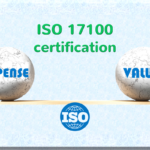
7 ways to build trust in marketing for LSPs
Marketing and Sales
Trust is the golden key to attracting high-quality customers. Easier said than done, but there is a way. Your translation clients need to believe that you can help them make or save money. How exactly? By providing them with fit-for-purpose translations or post-edited content.
Therefore, you should reinforce their belief by demonstrating your applied knowledge and skills. But also by showing the results your clients have achieved with your translations.
But how exactly do you build trust by doing marketing that feels real and true to you and not just looks like it was written by ChatGPT?
Here are seven ways you can incorporate trust-building elements into your LSP’s marketing strategy:
1. Real people, real reviews
Don’t just say it, show it! Mention client reviews prominently on your website, on LinkedIn, and in your ProZ profile. Mention names, photos, and quotes that highlight specific projects and the positive impact of your LSP.
Hearing about other people’s experiences satisfies our “auditory channel” of persuasion and reinforces our need for social proof. Social proof, a term coined by Professor Robert Cialdini, is a psychological and social phenomenon in which people mimic the actions of others in order to behave in a certain situation. For example, if you see a crowded restaurant, you might think that the food must be really good.
Basically, client reviews are a form of word-of-mouth advertising that is amplified by the internet. They:
● provide social validation
● reduce the perception of risk
● trigger positive emotions
– all of which are powerful motivators to buy.
Example: “We needed a culturally sensitive translation of our website for the Chinese market. LSP XYZ not only delivered accurate translations but also provided valuable insights to adapt our messaging for local audiences. Our website traffic from China has skyrocketed!” – Li Wang, Marketing Director, Tech Startup.
P.S. Don’t forget to share your client reviews on your social media profiles ASAP.
2. Case studies: Showcasing expertise in action
Go beyond reviews with detailed case studies. Document the challenges of a project, the solutions your LSP delivered, and the quantifiable results that were achieved. The focus here is on results, not only on facts and figures that make you a credible potential supplier.
If you don’t have concrete results to show yet or your client hasn’t shared them with you, you can still write a blog post about how you helped a big client complete a large project on time.
A case study satisfies our “read” channel of persuasion, where we need to immerse ourselves in a lengthy description of a process to be convinced that we’ve made the right decision to buy. With a bazillion alternatives on the market, customers are often afraid of making the wrong decision. So help them reduce their fear of making the wrong decision.
Case studies go beyond simply listing features and benefits. They:
● tell a story of change
● provide social proof
● reduce the perception of risk
● create an emotional connection with potential customers.
This psychological impact makes case studies a powerful tool for B2B marketing, especially in the LSP industry where trust and expertise are paramount.
Example: A medical device company needed its product manuals translated into several European languages for regulatory compliance. Your LSP case study details how you assembled a team of medical translation specialists, ensured terminological consistency, and delivered the translations on time, allowing the client to launch their product simultaneously across multiple markets. The results were fabulous as the sales skyrocketed since the launch.
P.S. Don’t forget to share your case studies on your social media profiles ASAP.
3. The power of demonstration
Offer free sample translations or advice on language solutions in the form of demonstrations. Let potential customers experience your expertise first-hand.
A demonstration satisfies our persuasion channel, according to which we are not convinced that a provider is the right choice for us until they try working with us. Interactive demonstrations can help potential clients feel more involved and invested in your translation service. This can lead to a stronger sense of commitment.
The special thing about demonstrations is that they appeal to multiple senses – visual, auditory, and sometimes even tactile. This creates a more immersive and memorable experience and makes your service seem more real and tangible.
Demonstrations address a key psychological hurdle in decision-making – the fear of the unknown. Offering a low-risk interactive experience, such as a free trial translation or consultation, can help potential customers overcome their uncertainty, build trust, and create a stronger emotional connection to your language services.
Example: Provide a free sample (a page or two) translation of a client’s key marketing materials, showcasing your understanding of their industry and target audience.
P.S. Don’t forget to share your free offering on your social media profiles ASAP.
4. Vulnerability: Strength in imperfection
Talk about (curated) client challenges you’ve overcome, your limitations and admit some of your mistakes (in a measured way). This shows your ability to handle complex projects and build trust by showing your true, authentic self. In an age where the media is flooded with perfect photos of perfect people, showing your human nature and vulnerability helps you to build a human connection.
However, it’s important to be strategic when marketing vulnerability. Oversharing or negativity can backfire. The most important thing is to be authentic, concrete and growth-oriented. Show your vulnerability in a way that highlights your strengths, learning experiences and commitment to improvement.
Example: “We once encountered a situation where a client’s source document contained cultural references specific to a particular region, and we didn’t know how to approach it. There was no knowledgeable translator to be found. By collaborating with the client and leveraging our network of native-speaking translators, we ensured the translated message resonated with the target audience at the end.”
P.S. Don’t forget to share your story on your social media profiles ASAP.
5. Personal results: Beyond numbers
Highlight the human impact of your work. How have your translations helped clients achieve more than just their goals? How have they made your clients’ lives easier?
Talking about personal results normally triggers emotions, and it is the emotions that make us take some action. We normally don’t go to a concert if we just think about it, we have to feel the music or the performer to buy that ticket.
Example: “A non-profit organization needed their educational materials translated to reach underserved communities in our region. We were proud to be a part of this project, knowing that our translations would empower individuals and bridge the gap to essential resources.”
P.S. Don’t forget to share your results on your social media profiles ASAP.
6. Expert endorsements: Borrowing credibility
Partner with industry experts for testimonials or co-created content such as a blog, article, or webinar. This validates your expertise from a trusted source and satisfies the need for social proof and “hear” channel of persuasion.
Clients often rely on mental shortcuts to simplify decision-making. Expert endorsements act as a powerful mental shortcut, providing a quick and reliable cue to your service quality or effectiveness. If a trusted expert approves, it can significantly reduce the perceived risk of trying a new service.
Example: Partner with a language industry association or translation technology leader to co-host a webinar on best practices in medical translation.
P.S. Don’t forget to share your endorsements on your social media profiles ASAP.
7. Show Your personality: Let your LSP shine through
Infuse your marketing materials with your company culture and values. Let your team’s personalities shine through blog posts or social media content because the clients will see who you are, that you are not just a brand name hiding behind random texts.
Personality goes beyond dry facts and figures. It allows you to express your brand’s values, sense of humor, or passion for languages. This emotional connection fosters a deeper bond with potential clients, making your LSP more memorable and endearing.
However, it’s important to strike a balance. Your personality should be relevant to your target audience and the overall brand image.
Example: Host a “Meet the Team” video series on social media, where your translators share their expertise and passion for languages in a fun and engaging way.
P.S. Don’t forget to share your human side on your social media profiles ASAP.
- In a nutshell, by incorporating these elements, your LSP can build trust through authentic marketing that speaks to the hearts, not just the minds, of potential clients. If something stays in clients’ heads only, it is highly unlikely they will take some action.
- Remember, trust is a journey, not a destination. Consistent effort, transparency, and a focus on client needs will pave the way for long-term success.
If you want to learn more about how we can help with your LSP growth, please take a look at our business support program for LSPs.











